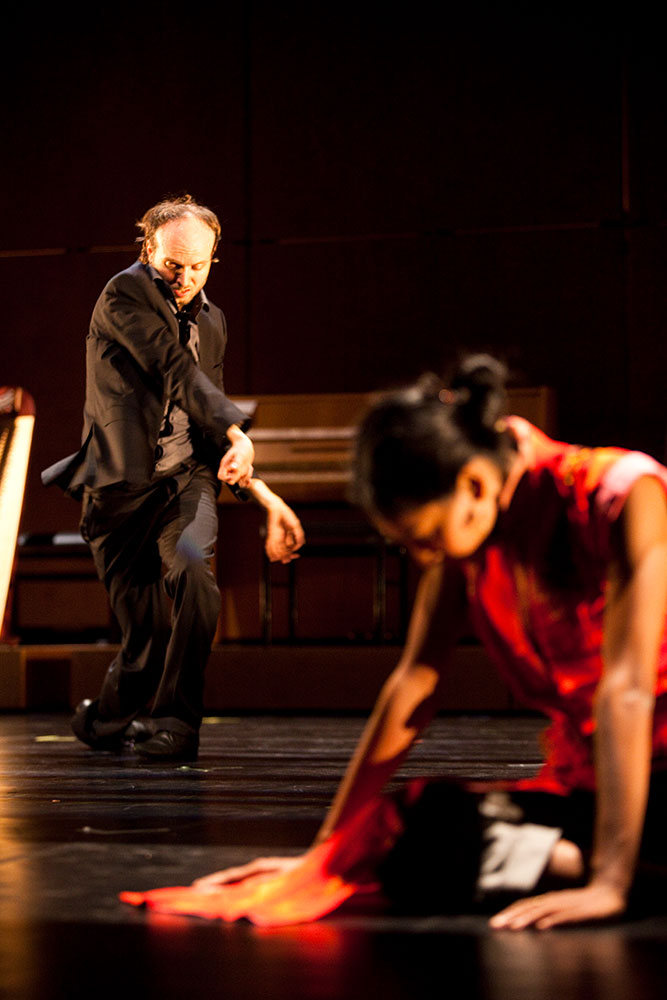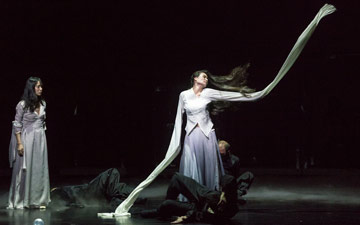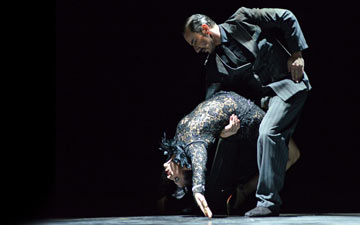
© Koen Broos. (Click image for larger version)
Sidi Larbi Cherkaoui and Shantala Shivalingappa
Play
★★✰✰✰
London, Queen Elizabeth Hall
4 September 2018
www.east-man.be
www.shantalashivalingappa.com
www.southbankcentre.co.uk
The year before Pina Bausch died in 2009, she invited Sidi Larbi Cherkaoui, the Flemish-Moroccan choreographer, to work with South Indian dancer Shantala Shivalingappa, who has performed with Bausch’s Tantztheater Wuppertal company. The result, Play, dedicated to Pina Bausch, has been revived several times, with just one night in London during this year’s tour.
Cherkaoui has frequently collaborated with performers from different cultures: Shaolin monks, flamenco diva Maria Pagès, Chinese dancer Yabin Wang, British-Bengali Akram Khan. Cherkaoui runs his own company, Eastman, in Antwerp and is artistic director of the Royal Ballet of Flanders. He is about to create a one-act work for our Royal Ballet in March 2019. It’s projected as ‘a new stylistic fusion’ to match that of Khan’s creations for English National Ballet.
Khan, 44, has announced his intention to retire from performing in full-length pieces once he has toured his last solo, XENOS. Maybe Cherkaoui, 42, should consider following his example. He looks older than his years, so much so that his relationship in Play with Shivalingappa risks being unsettling. As dancers, they are no longer equals, as they must have been in 2008. He now resembles an ageing Westerner trying to impress, or at least keep up with, a beautiful Asian Kuchipudi dancer who can do anything he can do far, far better.
The title Play encompasses play-acting, taking on a new identity, playing a game or a musical instrument. The Latinate adjective ludic, meaning playful, all too easily morphs into ludicrous. When Shivalingappa slips off her high heels to launch into rhythmic Kuchipudi pacing and stamping, Cherkaoui attempts to follow her lead. At first acting clumsily, he becomes more proficient until he can stamp in unison with her. But he remains a dad-dancing fool. What may have seemed endearing when Play was still a work-in-progress, now looks inept in a well-rehearsed show with little room for spontaneity.

© Koen Broos. (Click image for larger version)
It starts as a musical concert, with six players and their instruments arrayed on a wooden platform. They can all sing and perform a variety of genres of music, ancient and modern, Western and Eastern. The two dancers detach themselves to play a game of chess, with their moves projected onto a video screen above them. The platform splits into a series of plinths, choreographically re-arranged for scene changes by members of the Eastman company.
After trying out Shivalingappa’s dance form, Cherkaoui introduces her to contemporary tumblings. She moves freely and gracefully: he no longer does, though he retains some of his acrobatic skills. They both put on grotesque masks and behave like puppets. Standing above her, Cherkaoui mimes pulling her strings as she sings and tells a story with flexible fingers. Just what are they conveying?
Cherkaoui adopts the role of a mad old puppet instructor, commanding Shivalingappa to execute more and more intricate steps, to the audience’s delighted giggles. So he does know he looks ridiculous – but maybe not how distasteful he seems when, abandoning the puppet plays, he embraces her closely in a waltz or tango. When she launches into flirtatious Kuchipudi sequences, he resembles a creepy Western predator in a dance hall.
A scene initiated by the Japanese drummer, Tsubasa Hori, comes as a relief because it’s simply a play of hands on a table top (reminiscent of Jonathan Burrows’ and Matteo Fargion’s tapping routines). The elaborate rhythmic patterns are filmed from above and shown on the overhead screen used for the chess game. Around the table, the four participants watch each other closely, competing and collaborating in the percussive ritual. In later scenes, the hands play a card game and manipulate a Rubik cube.
The structure of the piece is episodic, like Bausch’s creations. For no obvious reason, Cherkaoui, blindfolded, sings a banal song from Walt Disney’s Aladdin (‘A Whole New World’) before Shrivalingappa, cross-legged, recites a long, platitude-ridden lecture about mind-training. All six performers join together to play notes on the piano before assuring us, in song, that ‘Everything is possible’. The end.

















You must be logged in to post a comment.